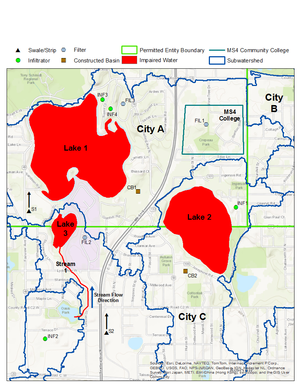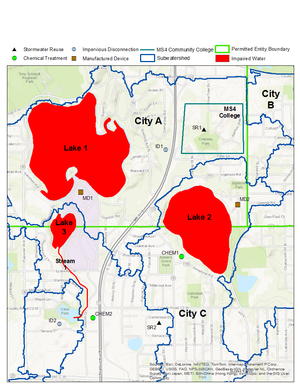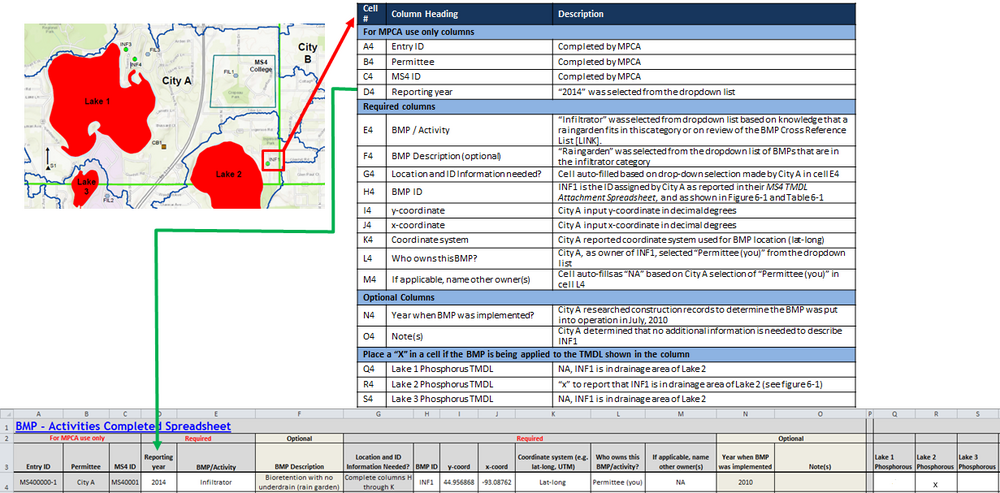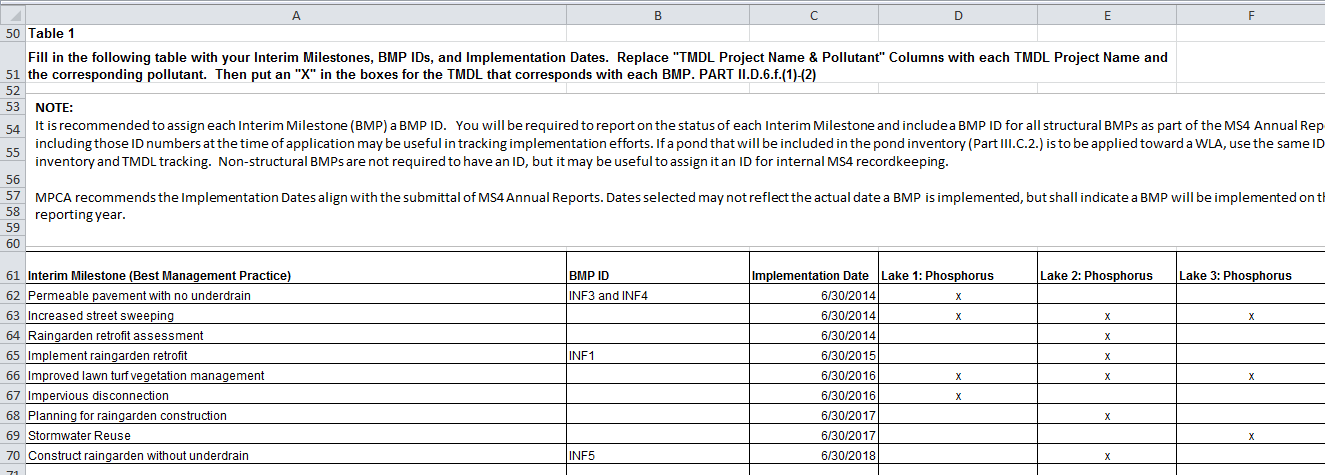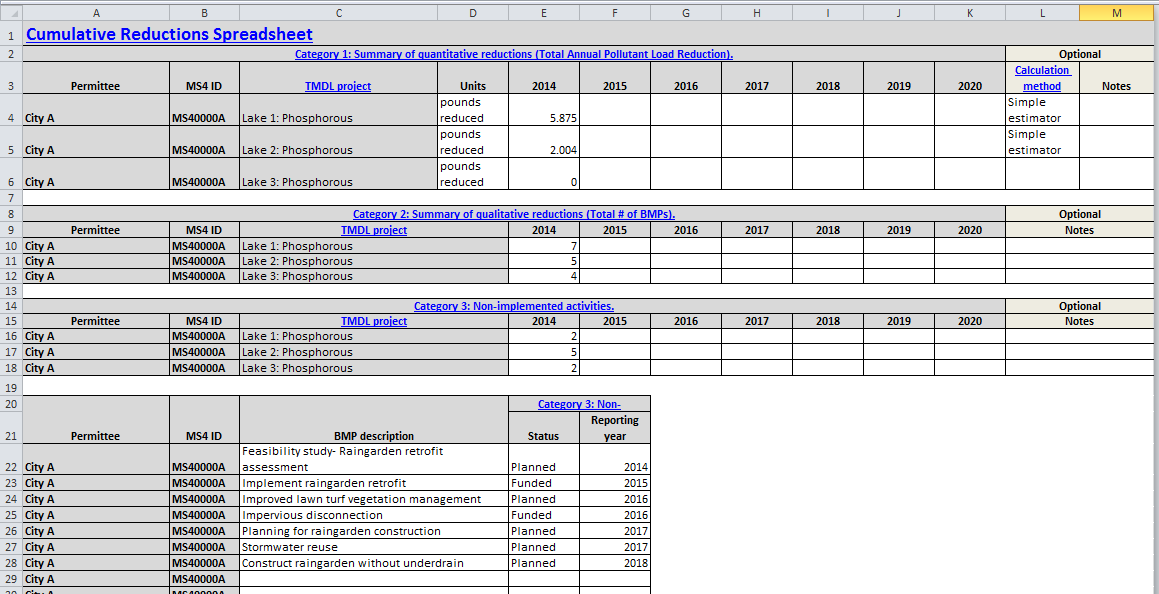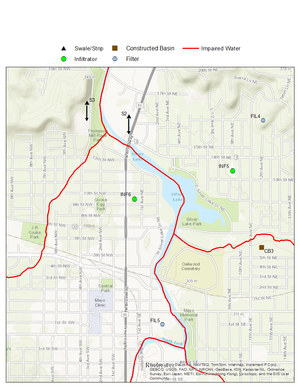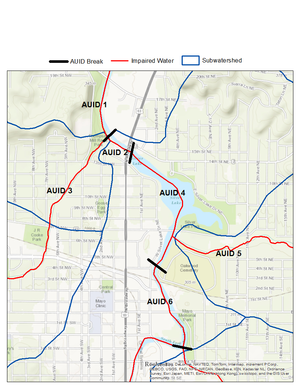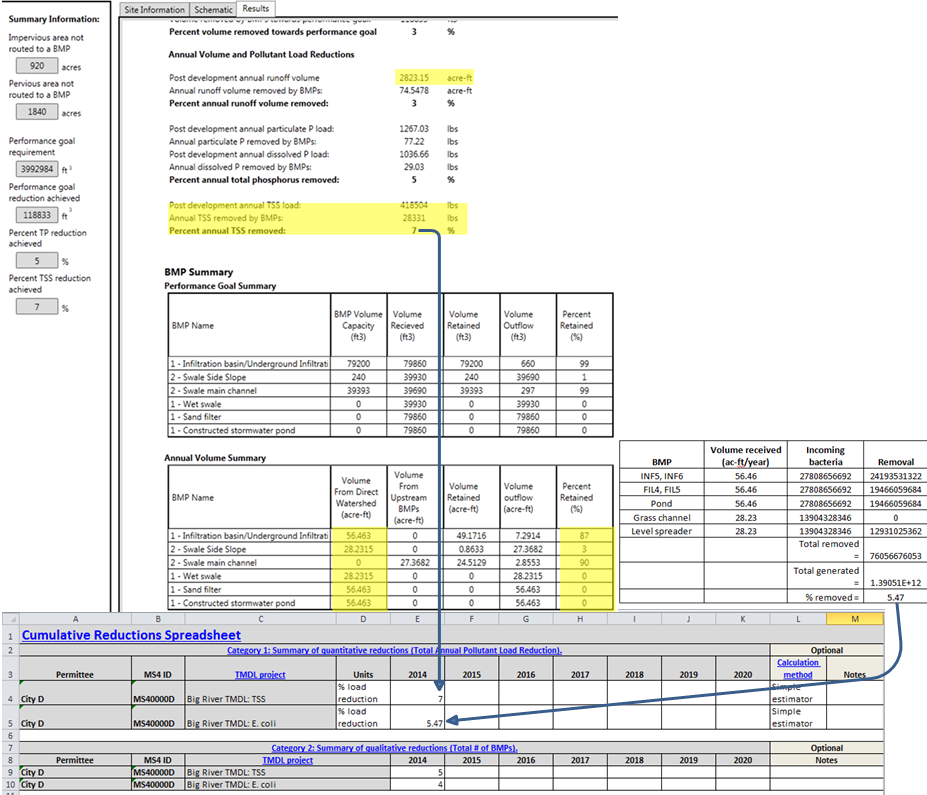
Difference between revisions of "Examples for completing the TMDL reporting form"
(→City D) |
|||
| Line 211: | Line 211: | ||
====City D==== | ====City D==== | ||
| + | |||
[[file:CityDannualReport2.png]] | [[file:CityDannualReport2.png]] | ||
Revision as of 18:06, 31 December 2014
Contents
Examples for completing the TMDL reporting form
The purpose of this section is to provide step-by-step examples on how to fill out the three required tabs in the TMDL Form. These are the BMP-Activites completed tab, the Cumulative reductions tab, and the Adaptive management strategy tab. The Permittee is not required to report on every BMP/activity that has been implemented, but instead just on those BMP/activities that are being applied to applicable WLAs. Each BMP contained in the dropdown box of column E of the BMP-Activities completed tab will be covered in the examples. Please read overview of categories before continuing on with the examples.
In order to complete the TMDL reporting form, it is important that the permittee have a means to:
- Define the watersheds of applicable TMDLs
- Plot structural BMPs within their jurisdiction, and
- Determine which BMPs are treating discharges to which impaired waters
This information is provided in the figures we will be referring to throughout each example. The subsequent sections will demonstrate how to take that information and translate it to the TMDL reporting form.
Scenario 1: Metro Watershed WRAPS
This example set uses Maps 1 and 2, which appear on the right hand side of the page. Each map covers the same area, however, Map 1 depicts structural BMPs and Map 2 depicts non-structural BMPs. Regardless of BMP type, the TMDLs required to be reported on are the same.
The example covers a metro area TMDL, the Metro Watershed WRAPS, with four MS4 permittees (City A, City B, City C, and MS4 College) and four impaired waters. The following TMDLs have been completed to address these impairments:
- Lake 1: Phosphorus
- Lake 2: Phosphorus
- Lake 3: Phosphorus
- Metro Watershed WRAPS: TSS (Stream 1)
- Metro Watershed WRAPS: E. coli (Stream 1)
- Lake TMDLs: Will be labeled by Waterbody + Pollutant. The title of the TMDL Project will therefore not be captured.
- Stream TMDLs: For ease of reporting, the Permittee is allowed to report on groupings of WLAs within the same report. Stream TMDLs will therefore be labeled by TMDL Project Name + Pollutant. For example, if the Permittee has TSS WLAs on four stream reaches in a single project, these will be grouped into one TMDL to report on. If the Permittee has been assigned WLAs for bacteria (whether they are expressed as fecal coliform or E. Coli) on the same four stream reaches in the same project, the Permittee would have two TMDLs to report on. Note that a Permittee may request to have the form customized to allow for individual reach reporting, however, the grouping convention will be the default.
BMP-Activities completed worksheet
This is the portion of the TMDL report form that the permittee will provide information on all BMPs being applied to a TMDL WLA/s.
City A
City A has been assigned WLA for three of the five TMDLs included in the Metro Watershed WRAPS project:
- Lake 1: Phosphorus
- Lake 2: Phosphorus
- Lake 3: Phosphorus
As noted in the previous section, the baseline year for each TMDL is 2010. Since the baseline, City A has implemented 14 BMP/activities that can be credited as progress toward achieving an applicable WLA. Note that all 14 BMP/activites do not apply to each TMDL WLA. The table below illustrates which TMDL each BMP can be credited to and in what category. See Map 1 for location of Category 1 BMPs and Map 2 for location of Category 2 BMPs. You will notice that there are four BMPs (employee education, establish ordinance, public education, and street sweeping) listed under Category 2 that are not located on Map 2. This is simply because they cannot be associated with a single point within the watershed. Also of note is the record under Category 3. Category 3 BMPs will not be translated to the BMP-Activities completed tab. These are activities that constitute progress, which meets the permit requirement for a given year, but cannot be associated with a reduction in pollutant loading.
BMPs City A will report
a INF1 and MD2 were constructed as a joint project between City A and City B
b These BMPs do not appear on the maps because they are not associated with a discrete location
c SR1 is owned by MS4 College, but City A contributes to maintenance (note that shared responsibility of maintenance can constitute a partnership between MS4s but continued maintenance of BMPs is a core permit requirement and cannot be used to demonstrate progress on a yearly basis)
The figure below demonstrates how information for one BMP, in this case INF1, would be input to the TMDL form by City A.
City A would continue this process until all appropriate BMPs from Table 1 have been translated to the BMP-Activites completed worksheet. When completed, City A's BMP-Activites completed worksheet may look similar to the following screenshot for 2014.
The screenshot below is an example of what City A's compliance schedule may have looked like at the time of application. Two of the three BMPs with a 2014 implementation date appear in the BMP-Activities completed worksheet above for the first reporting year. The third BMP, the raingarden retrofit assessment, will remain in Category 3 of the cumulative reductions worksheet. This record will not be moved for the duration of the permit term.
The screenshot below illustrates what City A's BMP-Activities completed worksheet may look like in 2015. The highlighted record is the only translation that needed to be made from the cumulative reductions worksheet because it was the only interim milestone scheduled to be completed. Another aspect of note is that the record for the initial INF1 BMP record (record 4) did not change. Furthermore, no record should be altered from a previous reporting year. The "BMP_improvement_enhancement_retrofitting" category, accompanied by an explanation in Column O, should be sufficient. If a unique situation presents itself, contact MPCA Stormwater for further guidance.
City B
City B has been assigned WLA for two of the five TMDLs in the Metro Watershed WRAPS project:
- Lake 1: Phosphorus
- Lake 2: Phosphorus
Since the baseline of the TMDL, City B has implemented four BMP/Activities that can be credited as progress toward achieving an applicable WLA. As depicted on Map 1, no structural BMPs are constructed within City B's jurisdiction. However, City B has collaborated with other MS4 permittees on the following projects:
- Provided funding to MS4 College on FIL1 for the Lake 1: Phosphorus TMDL, and
- Shares responsibility with City A for maintenance of MD2 (note that shared responsibility of maintenance can constitute a partnership between MS4s but continued maintenance of BMPs is a core permit requirement and cannot be used to demonstrate progress on a yearly basis)
City B may also record their supplemental street sweeping program because they do sweeping within the Lake 1 and Lake 2 watersheds. All BMPs listed in the table below must therefore be recorded as a Category 2 reduction unless the permittee can reasonably demonstrate an appropriate method for quantifying it in Category 1.
BMPs City B will report
a These BMPs do not appear on the maps because they are not associated with a discrete location
The screenshot below is an example of how the BMP-Activities completed worksheet may look when complete.
City C
City C has been assigned WLA for all five TMDLs included in the Metro Watershed WRAPS project:
- Lake 1: Phosphorus
- Lake 2: Phosphorus
- Lake 3: Phosphorus
- Metro Watershed WRAPS: TSS (Stream 1)
- Metro Watershed WRAPS: E. coli (Stream 1)
Since the baseline of the TMDL, City C has implemented eleven BMPs that can be credited as progress toward achieving an applicable WLA. The table below illustrates which TMDL each BMP can be credited to and in what category.
BMPs City C will report
The screenshot below is an example of how the BMP-Activities completed worksheet may look when complete.
MS4 College
MS4 College has been assigned WLA for one of the five TMDLs included in the Metro Watershed WRAPS project:
- Lake 1: Phosphorus
Since the baseline of the TMDL, MS4 College has implemented five BMPs that can be credited as progress toward achieving an applicable WLA. The table below illustrates which TMDL each BMP can be credited to and in what category. Note that MS4 College is located entirely within the jurisdiction of City A. This provides a unique partnership opportunity for the two MS4 permittees. For example, the two have an agreement in place for City A to perform street sweeping on campus.
BMPs MS4 College will report
a SR1 is owned by MS4 College, but City A contributes to maintenance
The screenshot below is an example of how the BMP-Activities completed worksheet may look when complete.
Cumulative reductions worksheet
This is the portion of the TMDL report form that the permittee will report the cumulative reduction achieved for each TMDL WLA. See the cumulative reductions section of the guidance for information on each of the reporting categories.
City A
The screenshot below illustrates how the cumulative reductions worksheet should look for City A 2014. Category 1 reductions were calculated using the simple estimator. Details for how this tool was used can be found in the guidance and examples for using the MPCA Simple Estimator.
The following screenshot is an example of City A's 2015 cumulative reductions submission. It is very similar to what was submitted in 2014 because only one BMP was implemented, that being the retrofit of INF1. This record was labeled as "Implement raingarden retrofit" in the 2014 cumulative reductions worksheet (row 23) and has therefore been translated to the BMP-Activities completed worksheet to show that the project has been fully implemented. This update is also reflected in Category 3 (cell E17 shows five planned but non-implemented activities for 2014 so F17 for 2015 shows four planned but non-implemented activities).
Because the implemented BMP improved the pollutant reduction capability of an existing structural BMP, INF1, it can be quantified in Category 1. Prior to the retrofit, INF1 treated 2 acres of Residential-medium density. Assuming the retrofit doubled the area treated by INF1 for the same land use, the cumulative reduction reported in 2015 for the Lake 2: Phosphorus TMDL would increase from 2.004 pounds to 4.008 pounds.
City B
City B had implemented no structural BMPs within its' jurisdiction from the baseline to the first year of reporting. All reductions are therefore reported as Category 2 and would appear as follows in the screenshot below.
City C
City C had implemented a variety of BMPs from the baseline of the TMDL to the first year of reporting. Similar to City A, reductions have been reported in both Category 1 and 2. Category 1 reductions were calculated using the simple estimator and examples of its use can be found in the guidance and examples for using the MPCA Simple Estimator.
MS4 College
MS4 College had implemented a variety of BMPs from the baseline of the TMDL to the first year of reporting. Reductions have therefore been reported in both Category 1 and 2. Category 1 reductions were calculated using the simple estimator and examples of its use can be found in the guidance and examples for using the MPCA Simple Estimator.
Adaptive management worksheet
Refer to the Adaptive Management Strategy section of the guidance for an example on how to fill out this portion of TMDL form.
Scenario 2: Big River TMDL
This example set uses Maps 3 and 4, which appear on the right hand side of the page. Each map covers the same area but Map 3 depicts structural BMPs and Map 4 depicts the six AUIDs (stream reaches) included as a part of the example.
The example covers an outstate area TMDL, the Big River TMDL, with one MS4 Permittee (City D). Each of the six stream reaches have TMDLs completed for TSS and E. coli. As a result of the lumping approach, this project has the following TMDLs to report on:
- Big River TMDL: TSS
- Big River TMDL: E. coli
- Lake TMDLs: Will be labeled by Waterbody + Pollutant. The title of the TMDL Project will therefore not be captured.
- Stream TMDLs: For ease of reporting, the Permittee is allowed to report on groupings of WLAs within the same report. Stream TMDLs will therefore be labeled by TMDL Project Name + Pollutant. For example, if the Permittee has TSS WLAs on four stream reaches in a single project, these will be grouped into one TMDL to report on. If the Permittee has been assigned WLAs for bacteria (whether they are expressed as fecal coliform or E. Coli) on the same four stream reaches in the same project, the Permittee would have two TMDLs to report on. Note that a Permittee may request to have the form customized to allow for individual reach reporting, however, the grouping convention will be the default.
BMP-Activities completed worksheet
This is the portion of the TMDL report form that the permittee will provide information on all BMPs being applied to a TMDL WLA/s.
City D
City D has been assigned WLA for both TSS and E. coli for all six of the impaired stream reaches included in the Big River TMDL. Therefore, the reporting requirement is as follows:
- Big River TMDL: TSS
- Big River TMDL: E. coli
Since the baseline of the TMDL, City D has implemented eleven BMPs that can be credited as progress toward achieving an applicable WLA. The table below illustrates which TMDL each BMP can be credited to and in what category.
The screenshot below is an example of how the BMP-Activities completed worksheet may look when complete.
Cumulative reductions worksheet
This is the portion of the TMDL report form that the permittee will report the cumulative reduction achieved for each TMDL WLA. See the cumulative reductions section of the guidance for information on each of the reporting categories.
City D
Adaptive management worksheet
Refer to the Adaptive Management Strategy section of the guidance for an example on how to fill out this portion of TMDL form.
